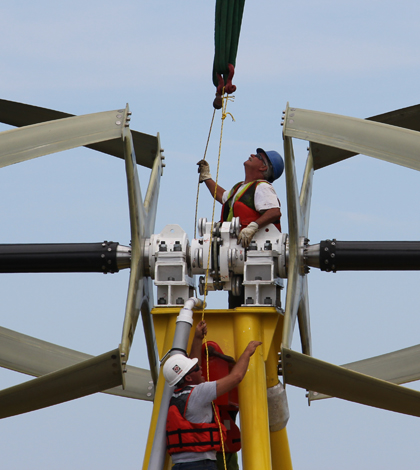Maine tidal energy development prompts study of environmental impacts

Crews work to install Ocean Renewable Power Company's TideGen generator (Credit: Ocean Renewable Power Company)
You don’t need an engineering degree to see why the Ocean Renewable Power Company chose Cobscook Bay for the pilot phase of its project to turn Maine’s coastal tides into electricity.
Their pilot site is nestled near the Canadian border in the larger Bay of Fundy, where 100 billion tons of water rush in and out each day with the force of 8,000 locomotives. That’s a lot of untapped renewable power.
But those epic tides are a double-edged sword.
“Working in the marine environment in general can be very challenging, but when you’re talking about eastern Maine and the weather conditions on the water, and then you add in a tidal element, it’s one of the most challenging environments you could possibly imagine,” said Nathan Johnson, director of environmental affairs for ORPC.
ORPC in 2012 received a license from the Federal Energy Regulatory Commission for its pilot project. In August 2012 the company mounted a single turbine on the ocean floor—making it the first project in the country to feed tidal power into the electric grid—but removed it in July 2013 for upgrades. The company eventually plans to generate five megawatts from Maine’s tides, which they say will power about 2,000 homes.
The FERC license requires ORPC to work with state and federal agencies to conduct environmental monitoring during the pilot phase. The company’s first environmental monitoring report, published in March, outlines how the turbine affects fish, birds, marine mammals, bottom-dwelling organisms and the tides themselves.
Its overall impact, according to the report: Not much.
Local residents and ORPC employees—who were trained in observation techniques by a marine ecologist—found no significant change in behavior among marine mammals when the turbine was installed and operated. Avian experts observed no disturbance to local seabirds. Laboratory simulations showed that turbines would have a negligible effect on the bay’s tides.

Boats at low tide in the Bay of Fundy (Credit: Boris Kasimov, via Flickr)
The results might have been tame, but reaching them required innovation, Johnson said.
“One of the challenges the tidal power industry is facing is that there’s no best available science out there,” he said. “We’re generating it as we go.”
Doing first-of-its kind research in a physically challenging environment “really made us think outside the box and come up with some innovative solutions for installation and environmental monitoring,” he added.
It was particularly difficult to measure the noise generated during installation and operation of the turbine—required because too much noise is a potential hazard to marine mammals—because the rush of water past a hydrophone was itself so loud.
“If you think of a news reporter standing out in the wind, with the wind going by the microphone, that’s the kind of noise you get from the tidal velocities,” Johnson said.
ORPC worked with Nashua, N.H.-based Scientific Solutions to minimize flow noise by suspending hydrophones beneath a drifting spar buoy.
To determine the turbine’s effects on local fish behavior, University of Maine researchers collaborating with ORPC used both high- and low-tech methods.

Crews work to install Ocean Renewable Power Company’s TidGen generator (Credit: Ocean Renewable Power Company)
In addition to using downward-looking sonar to map fish densities near the turbine and at a control site at different times of day and throughout the year, the team netted fish to determine which species were present. They also spoke with local fishermen to learn more about how fish populations move throughout the bay.
“Cobscook Bay is a big place, put it that way,” said Gayle Zydlewski, an assistant professor at the University of Maine’s School of Marine Sciences. “We figured, who better to talk to than the fishermen there?”
Zydlewski and colleagues also used side-looking sonar closer to the turbine to see how fish reacted to it. The turbine wasn’t in place long enough to draw clear conclusions, but it appears larger fish are better at avoiding the turbine, while smaller fish may pass safely between its thin blades, Zydlewski said.
“Because of the dynamics of the blade and the size of the fish going into the turbine, it’s not necessarily going to be like a blender, as some people think,” she said. “It might make fish move along the blade and not get struck by it.”
Another critical component of the environmental monitoring project is understanding how the turbine and its underwater transmission cable impacts the benthic community, since some of the most important species in the bay’s fishery are bottom-dwellers like scallops, which have declined in recent years.
Johnson said that’s an area where the tidal energy project may actually be helping the local environment.
“Now that our site is installed there, it’s on NOAA charts and there are cautionary notes to avoid it, so we’re actually seeing an increase in abundance of some species, and we think that’s due to the lack of dragging in the area,” Johnson said.
“In essence, it’s actually acting as something of a marine sanctuary.”





0 comments